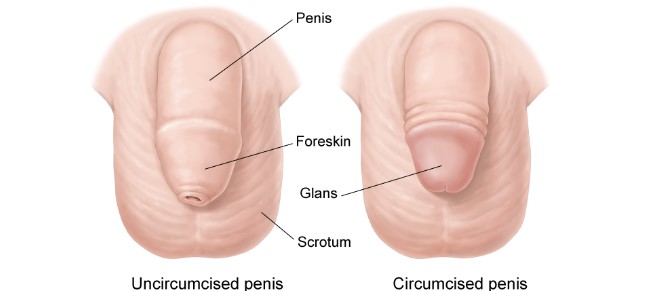There are some disadvantages of male circumcision to a woman which have been listed in this article. Male circumcision has been a longstanding cultural and religious practice, with a history dating back centuries. It involves the surgical removal of the foreskin from the penis, often performed for cultural, religious, or health reasons. While the focus has primarily been on the impact on men, it is essential to delve into the disadvantages this practice may pose to women, both socially and physically.
I. Introduction
A. Definition of Male Circumcision
Male circumcision is the surgical removal of the foreskin from the penis. It is a practice deeply rooted in various cultures and religions, often carrying significant social and symbolic meanings.
B. Brief History of Male Circumcision
The history of male circumcision dates back to ancient times, with evidence suggesting its practice in different civilizations. The reasons behind the tradition have evolved, encompassing cultural, religious, and purported health benefits.
II. The Procedure and Cultural Perspectives
A. Overview of the Circumcision Process
The circumcision process involves the removal of the foreskin, typically during infancy. Different cultures may have variations in the procedure, often accompanied by rituals and ceremonies.
B. Cultural and Religious Aspects Influencing Circumcision Practices
Cultural and religious beliefs play a crucial role in the decision to circumcise males. These perspectives contribute to the perpetuation of the practice across generations.
III. Health Implications for Men
A. Pros and Cons of Male Circumcision
The debate on the pros and cons of male circumcision is ongoing. While some argue for its potential health benefits, others question the necessity of the procedure.
B. Medical Risks and Benefits
From reduced risk of infections to concerns about complications, the medical aspects of male circumcision are multifaceted. It’s important to weigh the potential benefits against the associated risks.
IV. Social and Psychological Aspects
A. Impact on Body Image and Self-Esteem
Male circumcision can have implications for body image and self-esteem, particularly when cultural norms dictate its necessity. The societal perception of circumcised versus uncircumcised individuals may influence individuals’ self-perception.
B. Social Pressures and Cultural Expectations
Cultural expectations and societal norms can exert pressure on individuals and families to conform to the practice of male circumcision, potentially impacting mental and emotional well-being.
V. Disadvantages of Male Circumcision to a Women
1. Impact on Sexual Satisfaction:
Male circumcision, the surgical removal of the foreskin from the penis, may inadvertently influence sexual satisfaction for women. This stems from potential alterations in sensitivity or changes in the dynamics of intimate experiences. The physical aspects of circumcision could impact the overall satisfaction of sexual encounters, emphasizing the need to consider not only the health benefits for men but also the potential drawbacks for women.
2. Cultural Misconceptions:
Cultural beliefs associating male circumcision with cleanliness may significantly influence women’s perceptions. These misconceptions, rooted in societal norms, can perpetuate myths surrounding the practice and, consequently, affect intimate relationships. The cultural perspective linking circumcision to hygiene may create unfounded concerns among women, impacting their comfort and understanding within the context of relationships.
3. Body Image Issues:
The societal expectations and norms surrounding circumcised men can contribute to body image issues for both men and women. The perceived standards set by culture may influence individuals’ self-esteem and, in turn, affect the dynamics of their relationships. Understanding the psychological impact of these societal pressures is crucial in addressing the broader consequences of male circumcision on women’s well-being.
4. Psychological Distress:
Women may experience psychological distress due to the societal pressures and cultural expectations surrounding male circumcision. The impact on men’s mental and emotional well-being can extend to affect their female partners. Addressing the psychological aspects of circumcision is essential for fostering healthy relationships and understanding the intricate dynamics at play.
5. Risk of Infection:
While male circumcision may offer potential health benefits for men, there exists a risk of infection or complications associated with the surgical procedure. These risks can indirectly affect women within intimate relationships, highlighting the need for a balanced consideration of the potential drawbacks alongside the anticipated advantages.
6. Intimacy Challenges:
Physical changes resulting from male circumcision can introduce challenges in intimate relationships. Open communication and mutual understanding become paramount as couples navigate the potential adjustments required for maintaining a healthy and satisfying intimate connection.
7. Limited Control over Partner’s Decision:
In cultures where male circumcision is deeply ingrained as a societal norm, women may find themselves with limited influence over their partner’s decision to undergo the procedure. This lack of control can impact women’s well-being and emphasizes the importance of considering the autonomy of both individuals within a relationship.
8. Cultural Stigma:
Women may face societal stigma or judgment based on their partner’s circumcision status. This cultural stigma can influence relationships and contribute to a sense of alienation or exclusion within their communities. Understanding and addressing these societal perceptions is crucial for fostering inclusivity and support.
9. Educational Gaps:
The absence of comprehensive sexual education may contribute to misconceptions surrounding male circumcision. Bridging these educational gaps is essential to enhance women’s understanding of the practice and its potential implications, promoting informed decision-making within relationships.
10. Pressure to Conform:
Cultural and familial expectations can exert pressure on women to conform to the prevalent practice of male circumcision. Navigating these societal expectations requires careful consideration of individual autonomy and the promotion of open dialogue within communities.
11. Communication Challenges:
Couples may encounter challenges in discussing the potential disadvantages of male circumcision. Effective communication becomes crucial in addressing concerns, fostering understanding, and maintaining a healthy relationship dynamic.
12. Interference with Intimacy:
Surgical complications or discomfort resulting from male circumcision can interfere with the physical aspects of intimacy. Couples navigating these challenges may need to prioritize communication and seek mutual understanding to ensure the well-being of both partners.
13. Perceived Hygiene Concerns:
Cultural beliefs associating circumcision with cleanliness may give rise to unfounded concerns about hygiene within intimate relationships. Addressing these perceived hygiene concerns is vital to fostering a supportive and comfortable environment for both partners.
14. Impact on Relationship Dynamics:
Male circumcision can influence power dynamics within relationships. Understanding these shifts and their potential impact on decision-making processes is essential for maintaining healthy relationship dynamics and mutual respect.
15. Generational Expectations:
Women may face pressure from older generations to adhere to cultural norms related to male circumcision. Addressing generational expectations requires acknowledging the importance of cultural sensitivity while fostering open conversations to navigate potential challenges and promote individual choices within relationships.
VI. Ethical Considerations
A. Informed Consent and Bodily Autonomy
The ethical dimensions of male circumcision revolve around issues of informed consent and bodily autonomy. Ensuring individuals have the right to make decisions about their bodies is a fundamental consideration.
B. Ethical Debates Surrounding Male Circumcision
Discussions about the ethicality of male circumcision often center on cultural traditions versus individual rights. Ethical considerations extend to the potential impact on women affected by these practices.
VII. Global Perspectives
A. Varied Cultural Practices and Acceptance
Cultural practices surrounding male circumcision vary globally. Understanding these variations is essential in comprehending the broader impact on women in different societies.
B. International Views on Male Circumcision
The international community holds diverse perspectives on male circumcision, reflecting the complexity of the issue on a global scale.
VIII. Alternatives and Education
A. Awareness of Alternatives to Male Circumcision
Promoting awareness of alternatives to male circumcision is crucial. Providing information on different cultural practices and health considerations can empower individuals to make informed choices.
B. The Importance of Comprehensive Sexual Education
Comprehensive sexual education plays a vital role in addressing misconceptions and promoting understanding about the various aspects of male circumcision and its impact.
IX. Public Health Implications
A. Preventative Measures and Implications for Public Health
Considering the potential health risks associated with male circumcision, public health initiatives should focus on preventative measures and education to minimize adverse effects on both men and women.
B. Challenges in Addressing the Disadvantages for Women
Overcoming the challenges in addressing the disadvantages of male circumcision for women requires a multi-faceted approach, involving education, cultural sensitivity, and advocacy.
X. Legal Frameworks and Human Rights
A. Legal Status and Regulation of Male Circumcision
The legal frameworks surrounding male circumcision vary across regions. Examining these frameworks is essential in understanding the intersection with human rights, particularly for women.
B. The Intersection with Human Rights, Particularly for Women
Ensuring the protection of human rights, particularly for women affected by male circumcision, requires a nuanced approach that considers cultural, legal, and ethical dimensions.
XI. Addressing Misconceptions
A. Common Myths Surrounding Male Circumcision
Dispelling common myths surrounding male circumcision is crucial in fostering informed discussions. Myths contribute to misconceptions and can perpetuate the disadvantages for women.
B. The Importance of Dispelling Misinformation
Educational efforts must focus on dispelling misinformation, addressing cultural myths, and providing accurate information to empower individuals to make informed decisions.
XII. Interviews and Personal Experiences
A. Perspectives from Individuals Affected by Male Circumcision
Gaining insights from individuals directly affected by male circumcision, including women, offers a valuable perspective on the real-world impact of this cultural practice.
B. Personal Stories Highlighting the Impact on Women
Sharing personal stories can humanize the experiences of women affected by male circumcision, shedding light on the complexities and challenges they face.
XIII. Future Considerations
A. Emerging Discussions and Debates
As societal perspectives evolve, emerging discussions and debates surrounding male circumcision will likely influence cultural practices and individual choices.
B. Potential Shifts in Cultural Perspectives and Practices
Anticipating potential shifts in cultural perspectives and practices is essential for understanding how the disadvantages for women may evolve in the future.
XIV. Conclusion for disadvantages of male circumcision to a woman
A. Recap of Key Points
Examining the disadvantages of male circumcision for women requires a comprehensive understanding of cultural, medical, and ethical dimensions. Addressing these issues involves dispelling myths, promoting education, and respecting human rights.
B. Encouraging Informed Decision-Making and Dialogue
Encouraging informed decision-making and open dialogue is crucial in navigating the complexities surrounding male circumcision. Individuals should have the autonomy to make choices aligned with their values and beliefs.
5 Unique FAQs about disadvantages of male circumcision to a woman
- Q: Does male circumcision directly impact women’s health? A: While male circumcision primarily involves men, its cultural and psychological aspects can indirectly influence women’s well-being. Understanding these dynamics is essential in promoting holistic health.
- Q: Are there alternatives to male circumcision that do not pose disadvantages to women? A: Yes, alternatives exist, and promoting awareness of these options is crucial. Comprehensive sexual education plays a pivotal role in informing individuals about culturally sensitive choices.
- Q: How do cultural beliefs surrounding male circumcision affect women’s perceptions? A: Cultural beliefs can shape women’s perceptions of cleanliness, intimacy, and societal expectations. Addressing these beliefs through education is vital in fostering understanding.
- Q: What role does informed consent play in the ethical considerations of male circumcision? A: Informed consent is central to ethical considerations. Respecting individuals’ autonomy in making decisions about their bodies is crucial in navigating the ethical complexities of male circumcision.
- Q: How can communities address the challenges in advocating for women affected by male circumcision? A: Advocacy requires a collaborative effort involving education, cultural sensitivity, and legal frameworks. Engaging communities in open dialogue and dispelling myths are essential steps in addressing challenges.
Disclaimer
The information provided in this post is for general informational purposes only. It does not constitute professional advice or establish any professional-client relationship. The content is based on general knowledge and may not be applicable to individual circumstances. Readers are encouraged to seek professional guidance and conduct their own research to make informed decisions. The author and the platform shall not be held responsible for any actions taken or decisions made based on the information provided in this post. Any reliance on the content is at the reader’s own risk. Additionally, the content may not reflect the most up-to-date information, and the author and the platform disclaim any responsibility for inaccuracies or omissions in the content.


